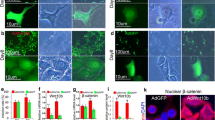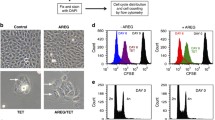Abstract
Background
SOX4 is a transcription factor belonging to the SOX (Sry-related High Mobility Group [HMG] box) family and plays a pivotal role in various biological processes at various stages of life. SOX4 is also expressed in the skin in adults and has been reported to be involved in wound healing, tumor formation, and metastasis.
Methods and results
In this study, we investigated the role of SOX4 in keratinocyte phenotypic changes. We generated a SOX4-overexpressing keratinocyte cell line that expresses SOX4 in a doxycycline (DOX)-inducible manner. DOX treatment induced a change from a paving stone-like morphology to a spindle-like morphology under microscopic observation. Comprehensive gene analysis by RNA sequencing revealed increased expression of genes related to anatomical morphogenesis and cell differentiation as well as decreased expression of genes related to epithelial formation and keratinization, suggesting that SOX4 induced EMT-like phenotype in keratinocytes. Differentially expressed genes (DEGs) obtained by RNA-seq were confirmed using qRT-PCR. DOX-treated TY-1 SOX4 showed a decrease in the epithelial markers (KRT15, KRT13, KRT5, and CLDN1) and an increase in the mesenchymal marker FN1. Protein expression changes by Western blotting also showed a decrease in the epithelial marker proteins keratin 15, keratin 13, and claudin 1, and an increase in the mesenchymal marker fibronectin. Removal of DOX from DOX-treated cells also restored the epithelial and mesenchymal markers altered by SOX4.
Conclusion
Our results indicate that SOX4 reversibly induces an EMT-like phenotype in human keratinocytes via suppression of epithelial marker genes.




Similar content being viewed by others
Data availability
The datasets generated during and/or analyzed during the present study are available from the corresponding author upon reasonable request.
References
van Houte LP, Chuprina VP, van der Wetering M, Boelens R, Kaptein R, Clevers H (1995) Solution structure of the sequence-specific HMG Box of the lymphocyte transcriptional activator Sox-4. J Biol Chem 270:30516–30524. https://doi.org/10.1074/jbc.270.51.30516
Hanieh H, Ahmed EA, Vishnubalaji R, Alajez NM (2020) SOX4: epigenetic regulation and role in tumorigenesis. Semin Cancer Biol 67:91–104. https://doi.org/10.1016/j.semcancer.2019.06.022
Jauch R, Ng C, Narasimhan K, Kolatkar PR (2012) The crystal structure of the Sox4 HMG domain-DNA complex suggests a mechanism for positional interdependence in DNA recognition. Biochem J 443:39–47. https://doi.org/10.1042/BJ20111768
Foronda M, Martínez P, Schoeftner S, Gómez-López G, Schneider R, Flores JM, Pisano DG, Blasco MA (2014) Sox4 links tumor suppression to accelerated aging in mice by modulating stem cell activation. Cell Rep 8:487–500. https://doi.org/10.1016/j.celrep.2014.06.031
Qi Miao MC, Hill F, Chen Q, Mo AT, Ramos KC, Sock E, Lefebvre V, Nguyen H (2019) SOX11 and SOX4 drive the reactivation of an embryonic gene program during murine wound repair. Nat Commun 10:4042. https://doi.org/10.1038/s41467-019-11880-9
Blanpain C, Fuchs E (2006) Epidermal stem cells of the skin. Annu Rev Cell Dev Biol 22:339–373. https://doi.org/10.1146/annurev.cellbio.22.010305.104357
Martin P (1997) Wound healing–aiming for perfect skin regeneration. Science 276:75–81. https://doi.org/10.1126/science.276.5309.75
Donati G, Rognoni E, Hiratsuka T, Ali KL, Hoste E, Kar G, Kayikci M, Russell R, Kretzschmar K, Mulder KW, Teichmann SA, Watt FM (2017) Wounding induces dedifferentiation of epidermal Gata6+ cells and acquisition of stem cell properties. Nat Cell Biol 19:603–613. https://doi.org/10.1038/ncb3532
Ge Y, Gomez NC, Adam RC, Nikolova M, Yang H, Verma A, Lu CP, Polak L, Yuan S, Elemento O, Fuchs E (2017) Stem cell lineage infidelity drives wound repair and cancer. Cell 169:636–650. https://doi.org/10.1016/j.cell.2017.03.042
Thiery JP, Acloque H, Huang RY, Nieto MA (2009) Epithelial–mesenchymal transitions in development and disease. Cell 25:871–890. https://doi.org/10.1016/j.cell.2009.11.007
Kalluri R, Weinberg RA (2009) The basics of epithelial-mesenchymal transition. J Clin Invest 119:1420–1428. https://doi.org/10.1172/JCI39104
Liu Y, Cui L, Huang J, Ji EH, Chen W, Messadi D, Hu S (2016) SOX4 promotes progression in OLP-associated squamous cell carcinoma. J Cancer 7:1534–1540. https://doi.org/10.7150/jca.15689
Miyake Y, Nagaoka Y, Okamura K, Takeishi Y, Tamaoki S, Hatta M (2021) SNAI2 is induced by transforming growth factor-β1, but is not essential for epithelial–mesenchymal transition in human keratinocyte HaCaT cells. Exp Ther Med 22:1124. https://doi.org/10.3892/etm.2021.10558
Hatta M, Miyake Y, Uchida K, Yamazaki J (2018) Keratin 13 gene is epigenetically suppressed during transforming growth factor-b1-induced epithelial-mesenchymal transition in a human keratinocyte cell line. Biochem Biophys Res Commun 496:381–386. https://doi.org/10.1016/j.bbrc.2018.01.047
Maaten L, Hinton G (2008) Visualizing data using t-SNE. J Mach Learn Res 9:2579–2605
Bushati N, Smith J, Briscoe J, Watkins C (2011) An intuitive graphical visualization technique for the interrogation of transcriptome data. Nucleic Acids Res 39:7380–7389. https://doi.org/10.1093/nar/gkr462
Xu J, Lamouille S, Derynck R (2009) TGF-β-induced epithelial to mesenchymal transition. Int J Mol Sci 20:2767. https://doi.org/10.3390/ijms20112767
Lee JH, Massagué J (2022) TGF-β in developmental and fibrogenic EMTs. Semin Cancer Biol 86:136–145. https://doi.org/10.1016/j.semcancer.2022.09.004
Hao F, Wang N, Zhang Y, Xu W, Chen Y, Fei X, Wang J (2022) E2F7 enhances hepatocellular carcinoma growth by preserving the SP1/SOX4/anillin axis via repressing miRNA-383‐5p transcription. Mol Carcinog 61:975–988. https://doi.org/10.1002/mc.23454
Nieto MA, Huang RY, Jackson RA, Thiery JP (2016) EMT: 2016. Cell 166:21–45. https://doi.org/10.1016/j.cell.2016.06.028
Moreno CS (2020) SOX4: the unappreciated oncogene. Semin Cancer Biol 67:57–64. https://doi.org/10.1016/j.semcancer.2019.08.027
Li Q, Dong Z, Zhou F, Cai X, Gao Y, Wang L (2014) Krüppel-like factor 5 promotes lung tumorigenesis through upregulation of Sox4. Cell Physiol Biochem 33:1–10. https://doi.org/10.1159/000356645
Lamouille S, Xu J, Derynck R (2014) Molecular mechanisms of epithelial-mesenchymal transition. Nat Rev Mol Cell Biol 15:178–196. https://doi.org/10.1038/nrm3758
Jolly MK, Ware KE, Gilja S, Somarelli JA, Levine H (2017) EMT and MET: necessary or permissive for metastasis? Mol Oncol 11:755–769. https://doi.org/10.1002/1878-0261.12083
Acknowledgements
The authors are grateful to the Cooperative Research Project Program of Life Science Center for Survival Dynamics, Tsukuba Advanced Research Alliance (TARA Center), and the University of Tsukuba for their help with RNA-seq analysis and advice. We thank Tsukuba i-Laboratory for the RNA-seq library preparation and sequencing. Thanks are due to the Oral Medical Research Center of Fukuoka Dental College for allowing us the use of their equipment, including the CFX96 Real-time System, LAS-4000 imaging system, and BZ-9000.
Funding
This study was supported by JSPS KAKENHI (Grant no. JP17K11659).
Author information
Authors and Affiliations
Contributions
YN and MH conceived and designed the study. YN and YM performed the experiments. YN, KO, YY, KM, HD, AF, and MH analyzed the data. YN and MH wrote the manuscript. YN, YT, KT, and MH confirmed the authenticity of all the raw data. All authors have read and approved the final manuscript.
Corresponding author
Ethics declarations
Competing interest
The authors declare no competing interests.
Ethical approval
Not applicable.
Consent to participate
Not applicable.
Consent to publish
Not applicable.
Additional information
Publisher’s Note
Springer Nature remains neutral with regard to jurisdictional claims in published maps and institutional affiliations.
Supplementary Information
Below is the link to the electronic supplementary material.
Rights and permissions
Springer Nature or its licensor (e.g. a society or other partner) holds exclusive rights to this article under a publishing agreement with the author(s) or other rightsholder(s); author self-archiving of the accepted manuscript version of this article is solely governed by the terms of such publishing agreement and applicable law.
About this article
Cite this article
Nagaoka, Y., Takeishi, Y., Miyake, Y. et al. SOX4 reversibly induces phenotypic changes by suppressing the epithelial marker genes in human keratinocytes. Mol Biol Rep 51, 116 (2024). https://doi.org/10.1007/s11033-023-09035-7
Received:
Accepted:
Published:
DOI: https://doi.org/10.1007/s11033-023-09035-7




